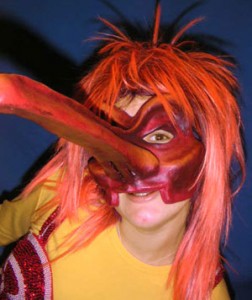A few years ago I was asked about my work with masks from different aspects for a scientific work by Thanos Vovolis at the Stockholm Academy of Dramatic Arts. I thought that I might as well share a bit of the answers here, except for the workshop in Mask Making I teach…
It is hard to say in general from where I start from when I make a mask. It has to do much about the genre and the character – obviously; the actor, what his face and his body look like and what he can do with it; the size of the mask and the size of the expression in the mask; whether it is going to be played in- or outdoors and what size the stage has; the style of the other masks in the play, if there is any, in order to make it into a whole.
I do not favor leather masks, especially for indoor work. Not just because they are more expensive or that they need a bigger workshop than I have access to, to make them, but I find them too rough in their expression for indoor use.
Over all I think that papier mache is an underrated material. It is more workable, easier to vary weight and thickness, it is possible to mix the paper with other materials, and one can make use of lines in the mask in another way, and so on.
The best is if the actors have the possibility to make their own masks with my supervision. It is not only touching to see the love the actors develop to their masks. It is also a way for the actors to come closer to their masks and in detail decide how the mask should be played. This is naturally happening on an unconscious level when the actors spend all this time with their masks.
I guess one could say that I become designer and they becomes the mask makers, but it is not really true since I don’t make any draughts or shape the clay or mix the colors myself. I try to leave as much of decisions as possible, within the given circumstances, to the actors. On the other hand am I following the work quit close so that I can influence how different choices color the result – both for the mask itself and how it works on stage or where to put the level of ambition.
As a matter of fact I don’t see it as a purpose of its own that the mask should be to “ready”. I am quite happy if the mask “works”. After all it is not an artwork to hang on the wall it’s a tool to use in the theatre. It would be fatal it the actual mask took the focus from the action and the actor
performing in it.


Pingback: About teaching mask – part 2 |
Pingback: The mask, costume and stage | Commedia dell'Arte & Vulgar Comedy
Pingback: About teaching mask | Commedia dell'Arte & Vulgar Comedy